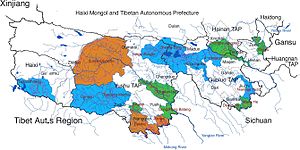Sanjiangyuan National Nature Reserve
| Sanjiangyuan National Nature Reserve | |||||||||

Sanjiangyuan National Nature Reserve
Wetland conservation
Wildlife conservation
Shrubland or forest conservation
|
|||||||||
| Chinese name | |||||||||
|---|---|---|---|---|---|---|---|---|---|
| Traditional Chinese | 三江源國家級自然保護區 | ||||||||
| Simplified Chinese | 三江源国家级自然保护区 | ||||||||
| Literal meaning | Three Rivers National Nature Reserve | ||||||||
|
|||||||||
| Abbreviation | |||||||||
| Traditional Chinese | 三江源自然保護區 | ||||||||
| Simplified Chinese | 三江源自然保护区 | ||||||||
| Literal meaning | Three Rivers Nature Reserve | ||||||||
|
|||||||||
| Tibetan name | |||||||||
| Tibetan | གཙང་གསུམ་འབུང་ཁུངས་རང་བྱུང་སྲུང་སྐྱོབ་ཁུལ། | ||||||||
|
|||||||||
| Transcriptions | |
|---|---|
| Standard Mandarin | |
| Hanyu Pinyin | Sānjiāngyuán Guójiājí Zìránbǎohùqū |
| IPA | [sántɕjáŋɥɛ̌n kwǒtɕjátɕǐ tsɹ̩̂ɻǎnpàuxûtɕʰý] |
| Transcriptions | |
|---|---|
| Standard Mandarin | |
| Hanyu Pinyin | Sānjiāngyuán Zìránbǎohùqū |
| Transcriptions | |
|---|---|
| Wylie | gtsang gsum 'bung khungs rang byung srung skyob khul/ |
| THDL | tsang sum bung khung rang jung sung kyop khül |
The Sanjiangyuan National Nature Reserve (SNNR) also referred to as the Sanjiangyuan Nature Reserve or the Three Rivers Nature Reserve, is the area of the Tibetan Plateau in Qinghai province, China which contains the headwaters of the Yellow River, the Yangtze River, and the Mekong River. The SNNR was established to protect the headwaters of these three rivers. The reserve consists of 18 subareas, each containing three zones which are managed with differing degrees of strictness.
Along with wetland and waters protection, other ecological values, such as grassland, forest, and wildlife enhancement, have also been presented as goals. To advance the goals of the SNNR uncontrolled or poorly managed mining, logging, hunting, and grazing have been curtailed. Foreign and other mining firms have replaced the uncontrolled miners, trees have been planted, and measures have been taken to protect endangered species. To protect the grasslands, pastoralists are not permitted to graze their animals in designated ‘core zones’ (see below), and grazing is supervised elsewhere in the SNNR. In addition, residents have been resettled from core zones and other grassland areas of the SNNR, and rangeland has been fenced and is in the process of being privatized throughout the Sanjiangyuan Area.
The Sanjiangyuan Area (Chinese: 三江源地区; pinyin: Sānjiāngyuán Dìqū) covers the southern and eastern parts of Qinghai and has an area of about 363,000 km2, 50.4% of Qinghai. Included in it wholly or partially are 18 counties of the four Tibetan Autonomous Prefectures Yushu, Guoluo, Hainan, and Haungnan, and Haixi Mongol and Tibetan Autonomous Prefecture. The Sanjiangyuan Area’s population is about 600,000, 90% of which are Tibetan. 70% of the Sanjiangyuan Area’s population are considered to be ‘impoverished’, with the average income of about 2000 RMB (roughly $300) per person/year. Since animal husbandry is the primary source of income, and many people are nomadic, this figure does not reflect the actual standard of living in a largely non-cash economy. The Sanjiangyuan Area in general has no special legal status, and the term is used to indicate the region in which the three rivers arise, and the SNNR exists.
The Sanjiangyuan National Nature Reserve (SNNR) is a subarea of the Sanjiangyuan Area which covers an area of about 152,300 km2, 21% of Qinghai, 42% of the Sanjiangyuan Area. It is larger than England and Wales combined. About 200,000 people traditionally live within the area covered by the SNNR. Since the government has been resettling people residing in the Sanjiangyuan Area, with over 60,000 resettled so far, and plans to resettle all nomads in Qinghai by 2011, it is unclear how current the figure of 200,000 is. The State Forestry Administration and the Qinghai government legally established the SNNR in May, 2000. Its Management Bureau was founded September, 2001, and the SNNR obtained State-level (national) status January, 2003. The Management Bureau is in Xining, and is under the Qinghai Forest Bureau. Mr. Wang Zhibao, Director of the State Forest Administration, has said the goals of the nature reserve protect the Qinghai-Tibet Plateau ecosystem, with a focus on alpine swamp meadow and the natural habitat of wildlife in the Sanjiangyuan Area.
...
Wikipedia
